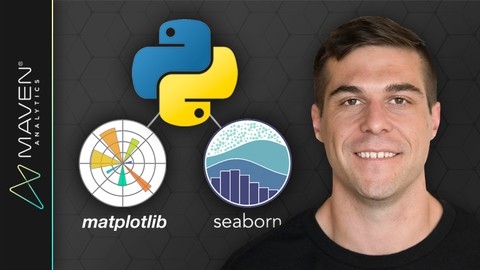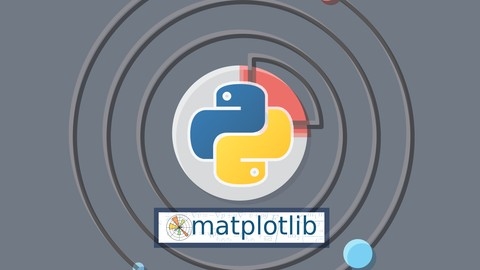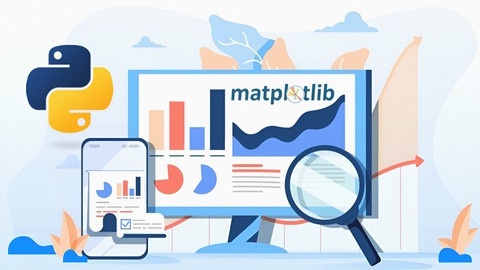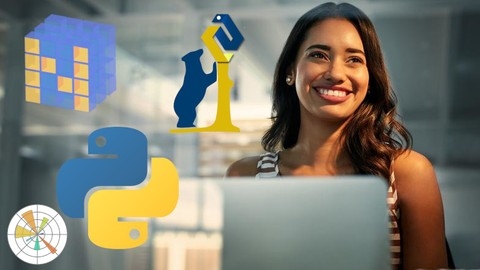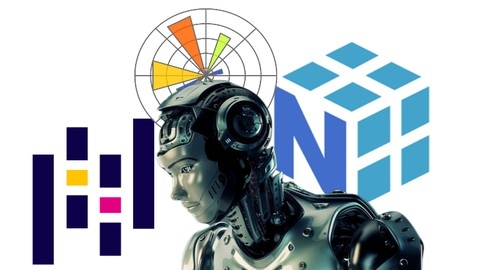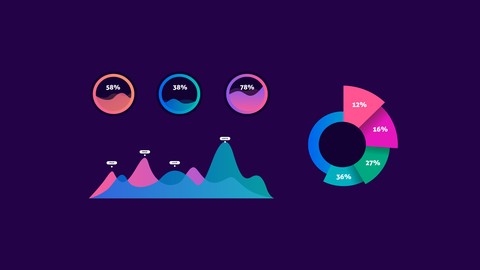Matplotlib is a cornerstone library in the Python ecosystem, renowned for its ability to create static, animated, and interactive visualizations in Python.
Mastering Matplotlib empowers you to transform data into insightful charts and graphs, unlocking hidden patterns and trends that can inform critical decisions.
Whether you’re a data scientist, a researcher, or a student eager to explore the world of data visualization, Matplotlib is an essential tool in your arsenal.
Finding a top-notch Matplotlib course on Udemy can be challenging, given the sheer volume of options available.
You’re searching for a course that not only covers the fundamentals but also delves into advanced techniques, providing hands-on exercises and practical examples to solidify your understanding.
The ideal course should be taught by experienced instructors who can guide you through the complexities of Matplotlib and inspire you to create stunning visualizations.
After reviewing numerous courses, we’ve concluded that the Complete Course on Data Visualization, Matplotlib and Python is the best overall Matplotlib course on Udemy.
This comprehensive course offers a structured learning path, starting with the basics and progressing to advanced topics like statistical charting and Seaborn integration.
The hands-on exercises and real-world examples ensure you gain practical experience and build a strong foundation in Matplotlib.
This is just one of the many excellent Matplotlib courses available on Udemy.
We’ve compiled a list of recommendations tailored to different learning styles and skill levels.
So keep reading to discover the perfect course to embark on your Matplotlib journey!
Complete Course on Data Visualization, Matplotlib and Python
This course on data visualization, Matplotlib, and Python offers a comprehensive learning experience.
You’ll begin with the fundamentals of Matplotlib, learning about Line2D for creating lines, Rectangle and FancyBboxPatch for shapes, and Text for adding labels and annotations.
This strong foundation prepares you for the next stages of the course.
You’ll then dive into creating various 2D charts like line charts, bar charts (including grouped and stacked variations), scatter plots, pie charts, and donut charts.
You’ll also explore histograms, polar charts, and even dual-axis charts for comparing multiple datasets.
As you progress, you’ll master the Axis object to customize labels, ticks, and spines, giving you fine-grained control over your charts’ appearance.
The course then takes you deeper into statistical charting techniques.
You’ll learn how to create autocorrelation plots, KDE plots, boxplots, and violin plots.
You’ll also discover how to generate heatmaps and use colorbars effectively to visualize complex data patterns.
This section equips you with the skills to explore your data in more sophisticated ways.
Finally, you’ll be introduced to Seaborn, a powerful library built on Matplotlib.
You’ll learn to use Seaborn functions like regplot, countplot, barplot, boxplot, violinplot, and swarmplot to create visually appealing and insightful statistical visualizations.
You’ll also explore more advanced Seaborn tools like factorplot, distplot, jointplot, and pairplot to analyze relationships between different variables in your data.
The course concludes with a review of core elements like legends, ticks, patches, lines, annotations, PathCollections (for customizing scatter plot markers), and Axes Spines.
This ensures you have a solid grasp of all the fundamental tools for creating impactful data visualizations.
Python Data Visualization: Matplotlib & Seaborn Masterclass
This course takes you on a journey from data visualization basics to creating stunning and insightful charts.
You begin with the fundamentals of Matplotlib, learning to build foundational charts like line charts, bar charts, and scatterplots, and how to customize them with colors, styles, and labels.
You then dive deeper into advanced Matplotlib techniques, mastering the art of subplots using GridSpec to construct intricate visualizations.
You discover the power of color palettes and stylesheets, giving your creations a professional and visually appealing edge.
As your journey progresses, you’ll explore Seaborn, a library built upon Matplotlib that offers a more intuitive approach to crafting visually engaging and informative charts.
You’ll learn to build advanced visualizations such as box plots, violin plots, heatmaps, and jointplots, enabling you to uncover hidden patterns and relationships within your data.
By seamlessly integrating Seaborn with your Matplotlib skills, you unlock even greater analytical and storytelling possibilities.
This course doesn’t just stop at theory.
You’ll work on practical projects using Jupyter notebooks and manipulate data with DataFrames, solidifying your understanding of Matplotlib and Seaborn.
You’ll analyze real-world data, including the global coffee market and used car sales, transforming raw data into compelling stories with charts and visualizations.
Through these hands-on projects, you’ll gain practical experience and build a portfolio showcasing your newfound data visualization expertise.
Data Visualization with Python and Matplotlib
This Matplotlib course takes you from installing Matplotlib to crafting sophisticated visualizations.
You’ll begin by mastering basic charts like Bar Charts, Scatter Plots, and Pie Charts.
You’ll learn how to load data from CSV files using NumPy, a powerful library for numerical operations in Python, and how to customize your charts with labels, titles, and legends to make your data easy to understand.
You’ll then move on to advanced customization techniques, learning how to create professional-looking financial charts, like Candlestick OHLC charts, that track stock prices.
You’ll discover how to add technical indicators like moving averages to these charts, customize axes and grids, and even build live, dynamically updating graphs for real-time data visualization.
The course also delves into geographical plotting using Basemap.
This allows you to create maps, customize their projections, and overlay data points on them.
You’ll discover how to plot coordinates on a map and connect them to visualize routes and connections.
Finally, you’ll explore the world of 3D graphing, where you’ll build eye-catching 3D Scatter Plots, Bar Charts, and intricate Wireframe plots to visualize complex data in an intuitive way.
You’ll learn how to manipulate and customize these 3D visualizations to highlight trends and patterns in your data.
Data Visualization with Python and New Methods in Matplotlib
This course equips you with the skills to create a variety of 3D visualizations, going beyond static charts to bring your data to life.
You will start with the fundamentals of 3D bar charts and histograms using Matplotlib, a cornerstone library for data visualization in Python.
You will then move on to more intricate techniques, mastering 3D contour plots, wireframes, and surface plots.
These skills will allow you to present complex data in an engaging and insightful way.
As you progress, you will delve deeper into the world of 3D data visualization.
You will learn to craft compelling 3D scatter plots and line graphs, adding a new dimension to your data exploration.
You will also explore the creation of surface and gradient surface plots and wireframe graphs, adding depth and sophistication to your visualizations.
The course doesn’t shy away from advanced techniques.
You will discover the power of polar plots, learning to create both polar scatter plots and contour plots.
This will allow you to visualize data in a circular format, particularly useful for cyclical or periodic data.
You will also explore Folium, a Python library that enables the creation of interactive heatmaps.
With Folium, you can bring geographical data to life, highlighting patterns and trends in an intuitive and engaging manner.
Python Data Science basics with Numpy, Pandas and Matplotlib
This course equips you with the essential skills to analyze data using Python, NumPy, Pandas, and Matplotlib.
You’ll start by building a strong foundation in Python, learning about strings, numbers, operators, lists, tuples, sets, and dictionaries.
This foundation in Python is your launchpad to dive into the world of data science.
You’ll then explore NumPy, where you’ll discover how to work with arrays and perform powerful numerical computations.
Arrays are like building blocks for organizing and analyzing data.
Imagine them as super-efficient containers for your numbers, making complex calculations a breeze.
Next, you’ll move onto Pandas, where you’ll learn how to work with DataFrames, which are essentially powerful spreadsheets within Python.
You’ll discover how to perform crucial tasks, from converting and dropping data to summarizing and selecting specific parts of your dataset.
You’ll also master the art of handling missing data, an essential skill for real-world data analysis, and learn how to organize your data through sorting.
Finally, you’ll dive into the world of data visualization with Matplotlib.
You’ll learn how to create various graphs and plots, including histograms, to represent your data visually.
This visual representation will help you uncover hidden patterns and gain a deeper understanding of your data.
NumPy, Pandas and Matplotlib A-Z™ for Machine Learning
This course provides a comprehensive understanding of data visualization with Matplotlib, equipping you with the skills to turn data into insightful visuals.
You’ll begin with NumPy, learning to create and manipulate arrays, essential building blocks for numerical computing in Python.
You’ll grasp the concept of arrays as scalars, vectors, matrices, and tensors, and become proficient with NumPy functions such as reshape, linspace, and arange for array manipulation.
The journey continues with Pandas, where you’ll explore DataFrames and Series, the backbone of data analysis in Python.
You’ll learn to import data from various sources like CSV, JSON, SQL databases, and Excel, mastering techniques to clean, manipulate, and perform statistical analysis on your datasets.
You’ll even discover how to interact with SQL databases directly through Pandas.
Finally, you’ll delve into the heart of data visualization with Matplotlib.
This section teaches you to build a variety of plots including line plots, scatter plots, bar charts, pie charts, and even 3D visualizations.
You’ll learn to customize these plots, adding labels, titles, legends, and grids to enhance clarity and convey insights effectively.
The course challenges you with practical exercises and provides solutions, solidifying your grasp of Matplotlib and its capabilities.
Matplotlib Intro with Python
This Matplotlib course takes you from the basics of loading data to crafting insightful visualizations.
You begin by mastering line charts, from simple plots to multi-line comparisons and eye-catching fill plots.
This foundation prepares you to explore other visualizations, each with a unique strength.
You learn to build bar charts for comparing categories, pie charts for illustrating proportions, and scatterplots for revealing relationships between variables.
You discover how to refine your plots with grids for organization and legends for clarity.
You gain the ability to save your work as images, ready to share your insights.
The course then guides you into advanced techniques.
You learn to create visually compelling themes and arrange multiple plots within a single figure using subplots.
Finally, you dive into the third dimension, mastering the art of 3D plots to add depth and perspective to your data stories.


